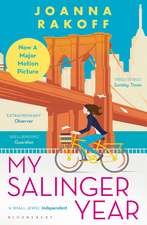Seeing Suffering in Women's Literature of the Romantic Era
Autor Elizabeth A. Dolanen Limba Engleză Hardback – 29 aug 2008
| Toate formatele și edițiile | Preț | Express |
|---|---|---|
| Paperback (1) | 436.14 lei 6-8 săpt. | |
| Taylor & Francis – 30 noi 2016 | 436.14 lei 6-8 săpt. | |
| Hardback (1) | 1061.81 lei 6-8 săpt. | |
| Taylor & Francis – 29 aug 2008 | 1061.81 lei 6-8 săpt. |
Preț: 1061.81 lei
Preț vechi: 1294.89 lei
-18% Nou
Puncte Express: 1593
Preț estimativ în valută:
203.18€ • 212.84$ • 168.39£
203.18€ • 212.84$ • 168.39£
Carte tipărită la comandă
Livrare economică 08-22 aprilie
Preluare comenzi: 021 569.72.76
Specificații
ISBN-13: 9780754654919
ISBN-10: 0754654915
Pagini: 260
Dimensiuni: 156 x 234 x 16 mm
Greutate: 0.66 kg
Ediția:New.
Editura: Taylor & Francis
Colecția Routledge
Locul publicării:Oxford, United Kingdom
ISBN-10: 0754654915
Pagini: 260
Dimensiuni: 156 x 234 x 16 mm
Greutate: 0.66 kg
Ediția:New.
Editura: Taylor & Francis
Colecția Routledge
Locul publicării:Oxford, United Kingdom
Cuprins
Contents: Introduction; Part 1 Illness: Melancholia and the poetics of visibility: Charlotte Smith's Elegaic Sonnets; Contagion, sympathy, invisibility: Mary Shelley's Frankenstein. Part 2 Healing: The journey to heal melancholia: Mary Wollstonecraft's Letters fron Norway; Scientific botany as therapy: Charlotte Smith's literature; Invisibility and the history of trauma: Mary Shelley's Rambles in Germany and Italy. Part 3 Social Justice: Seeing poverty: Smith's Rural Walks and Wollstonecraft's Original Stories as fictional ethnography; Unsentimental seeing: Wollstonecraft's The Wrongs of Woman and didactic children's literature; Afterword; Bibliography; Index.
Notă biografică
Elizabeth A. Dolan is associate professor of English at Lehigh University, USA.
Recenzii
'Elizabeth Dolan significantly modifies and deepens our understanding of the Romantic period, as she connects apparently disparate critical trajectories: medical understandings of the physiology of the eye, aesthetic and scientific modalities of seeing, and the discourse of suffering underlying social movements. Women writers, she argues, use this new knowledge to express their own subjectivity in innovative ways. Dolan reads Charlotte Smith, Mary Wollstonecraft, and Mary Shelley across genres and as they explode gendered constraints to visualize the suffering of neglected Others in radical and unavoidable ways.' Gina Luria Walker, New School University, USA ’... Recommended.’ Choice '... wide-ranging, interesting...' Keats-Shelley Journal
Descriere
As she explores tropes of illness, healing, and social justice in the writings of Mary Wollstonecraft, Charlotte Smith, and Mary Shelley, Dolan engages with a wide range of primary sources in science and medicine. She argues that the Romantic-era interest in the physiology of vision influenced the culture's understanding of suffering, and that these three authors experimented with materialist modes of seeing in order to expand the language of suffering and to claim literary authority.












